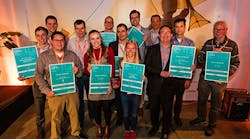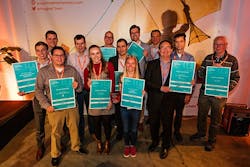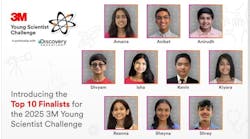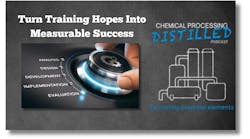[pullquote]
Fostering collaborative innovation is the aim of Imagine Chemistry, an annual contest started by AkzoNobel Specialty Chemicals in 2017. As I had noted last year (“Imagine Chemistry Challenge Awards Support to Startups”), the competition provides an offbeat but effective approach to cultivating relationships with groups developing technology relevant to the company.
AkzoNobel Specialty Chemicals is now an independent company, Nouryon. The Amsterdam-based firm ran this year’s installment of Imagine Chemistry.
Its motivation is simple: “We not only need to create more sustainable products — we also need to become more open and collaborative… No one company has all the answers,” stresses Renier Vree, Nouryon’s CFO.
The 2019 competition focused on five areas: pushing the frontiers of sustainable innovation; performance-boosting nanoparticles; sustainable bio-based surfactants; sensing in demanding chemical environments; and chemistries that don’t require labels on products. It attracted more than 160 submissions from 30 countries.
Representatives of the eight groups that won the Imagine Chemistry competition gather at the awards ceremony on May 24th at Nouryon Research Center in Deventer, the Netherlands.
Fourteen finalists then took part in a three-day event in late May at Nouryon’s research center in Deventer, the Netherlands. The judges picked two overall winners to receive joint development agreements (JDAs):
• Sironix Renewables, Seattle, for its plant-based detergent molecule that serves both as a surfactant and chelating agent, eliminating the need for co-formulated chemicals, and that provides enhanced performance in hard water. It garnered two JDAs, one from Imagine Chemistry partner Unilever for consumer personal care products and another from Nouryon for applications outside that area.
• Ionomr, Vancouver, B.C., received a JDA from Nouryon for its advanced environmentally friendly hydrocarbon ion-exchange membranes and polymers for electrochemical systems. These represent a fundamental shift from the perfluorinated sulfonic acid chemistry now used, and offer both markedly reduced toxicity and environmental impact.
In addition, six other groups won awards:
• Ingu Solutions, Calgary, obtained a supply agreement from Nouryon for its miniaturized, single-use inline sensors to detect leaks, defects and deposits in pipelines.
• RISE — Research Institutes of Sweden, Borås, Sweden, got a research agreement to further develop its vinyl functionalized reactive additives for commercially available metal oxide nanoparticles.
• Intelligent Fluids, Leipzig, Germany, garnered a research agreement with Nouryon plus partner support from ICOS Capital for its cleaning agents that use physical effects rather than toxic solvents.
• Cambridge Carbon Capture, Cambridge, U.K., gained partner support from Lux Research for its technology that captures carbon dioxide and converts it to a solid mineral byproduct with various commercial uses.
• Arenal Process Control Solutions, Pijnacker, the Netherlands, obtained chemical research support from Nouryon for its ultrasonic and thermal sensors for real-time process monitoring.
• The University of Sheffield, Sheffield, U.K., and Entomics Biosystems, Cambridge, U.K., received chemical research support from Nouryon for their work on using black soldier fly larvae to make surfactants.
Imagine Chemistry was planned as a three-year trial. Nouryon now is assessing the program and how best to carry it forward. This, for instance, may involve replacing the single multi-faceted annual competition with multiple ones, each focused on a specific technical area, spread out over the course of a year or two, says Marco Waas, global director RD&I and technology. “Focus will certainly be to bring the solutions which the finalists brought to us in the last three years to market.”
I expect Nouryon’s fine-tuning to make Imagine Chemistry even more valuable to the firm. I strongly urge other chemical makers to emulate this astute approach to collaborative innovation.




